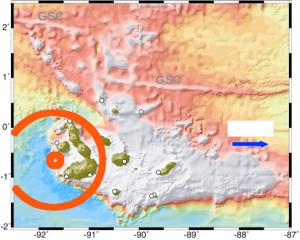Galapagos Structure

The mantle transition zone is thin over an area ~100 km in radius centered ~40 km SW of the island of Fernandina. => This anomaly is consistent with an excess temperature of 130 ± 60 K.
Active volcanism in the Galápagos occurs to the east and north.
-
1.The ascending mantle is transported north to the Galápagos spreading center by plume-ridge interactions.
-
2.The ascending mantle is spreads out both eastward and westward beneath the Nazca plate
Publications
*Byrnes, J.S., E.E.E. Hooft, D.R. Toomey, D.R. Villagómez, D.M. Geist, S.C. Solomon, An upper mantle seismic discontinuity beneath the Galápagos Archipelago and its implications for studies of the lithosphere-asthenosphere boundary, Geochemistry, Geophysics, Geosystems, doi: 10.1003/2014Gc005694, 2015.
*Villagómez D.R., D.R. Toomey, D.J. Geist, E.E.E. Hooft, S.C. Solomon, Seismic imaging reveals mantle flow and multistage melting beneath the Galápagos, Nature Geoscience, doi: 10.1038/NGEO2062, 2014.
Hooft Toomey, E.E.E., Toomey, D.R., Solomon, S.C., James, D.E. and Hall, M.L., Crustal Thickness Variations and Internal Structure of the Galápagos Archipelago, Eos Trans. AGU, 82, T42B-0939, 2001.
Toomey, D.R., E.E.E. Hooft Toomey, S.C. Solomon, D.E. James, and M.L. Hall, Seismic Evidence for a Plume Beneath the Galápagos Hotspot, Eos Trans. AGU, 83 (47), 2002.
